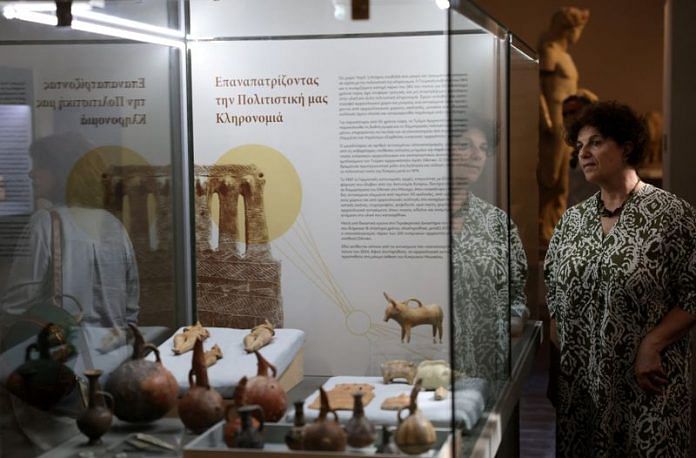NICOSIA (Reuters) – Cyprus has taken delivery of priceless antiquities looted after war split the island in 1974, as part of an ongoing effort to trace and repatriate thousands of artefacts fenced worldwide.
Authorities say thousands of antiquities were stolen and sold across the world after a Turkish invasion triggered by a brief Greek-inspired coup.
Items recovered range from church doors traced to Japan, bronze age antiquities in Australia, and priceless examples of early Christian art in the United States, taken from northern Cyprus, now a breakaway Turkish Cypriot state.
On Monday, authorities formally received 60 artefacts, including items from the chalcolithic and bronze age and a wallpainting from a church. Cypriot officials say looting is a concerted assault on the island’s cultural heritage.
“Hundreds of churches and archaeological sites have been plundered, with thousands of relics exported illegally from our occupied country,” Cypriot President Nikos Christodoulides told an event at the Cyprus Museum, a few yards (metres) away from a ceasefire line splitting the capital Nicosia.
The museum’s entire contents, chronicling Cyprus from 9,000 BC, was emptied and sent to Athens for safekeeping during 1974.
Monday’s collection are items repatriated from Germany, where in 1997 police found hundreds of artefacts at addresses leased by a Turkish art dealer who died in 2020.
Authorities have a dedicated task-force of specialists who trawl the internet and auctions daily for red flags.
“In most cases the items on sale are not accompanied by a record of legal acquisition to show it was legally exported from Cyprus,” said Eftychia Zachariou, Curator of Antiquities.
One of the most stark examples of looting covered the removal of a mosaic at the village of Lythrangomi in north Cyprus in the late seventies.
The 6th century mosaic – one of a few surviving pieces of religious art in the region before Byzantine emperors briefly banned images and icons – was hacked off the wall and broken into pieces and sold. Authorities have since recovered a number of pieces which are now on display in Cyprus’s Byzantine Museum.
(Reporting by Michele Kambas; Editing by Angus MacSwan)
Disclaimer: This report is auto generated from the Reuters news service. ThePrint holds no responsibilty for its content.




